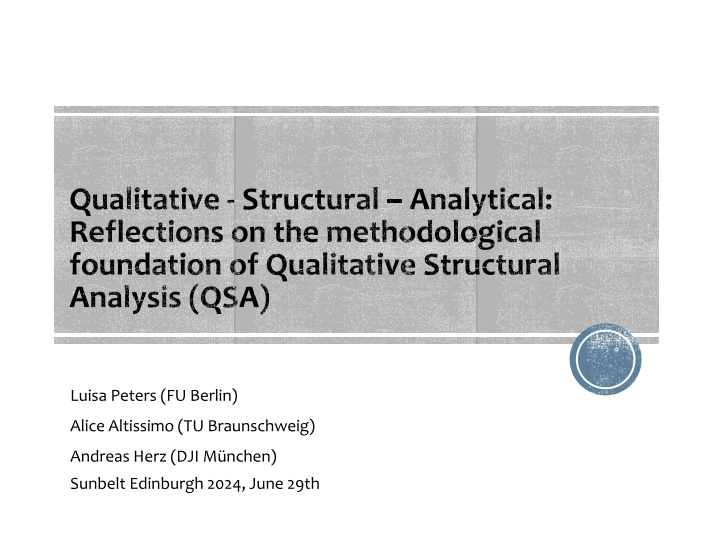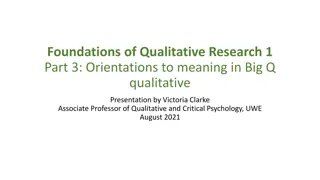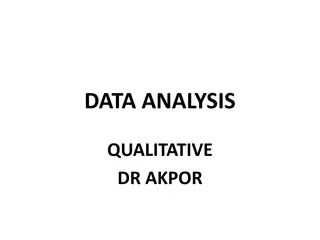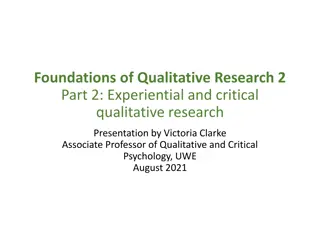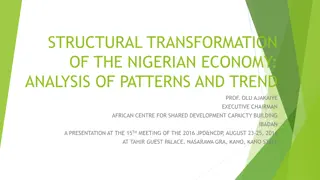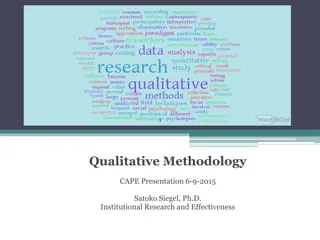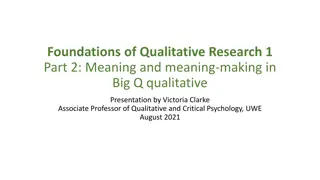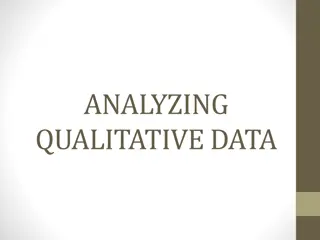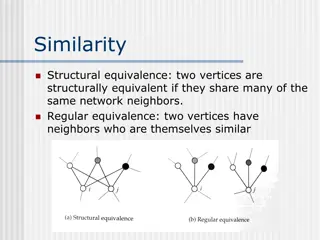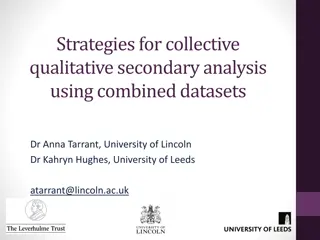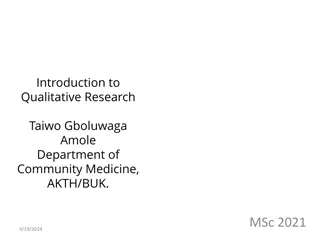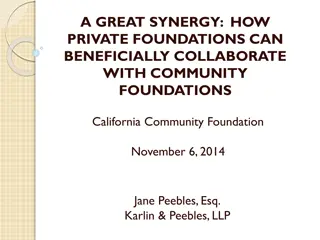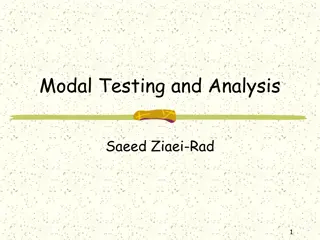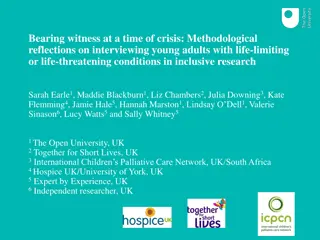Methodological Foundations of Qualitative Structural Analysis
This paper discusses the methodology of Qualitative Structural Analysis (QSA) and its importance in research. The authors, Luisa Peters, Alice Altissimo, and Andreas Herz, provide reflections on the methodological foundation of QSA based on their research experiences. The presentation took place at Sunbelt Edinburgh in June 2024.
Download Presentation

Please find below an Image/Link to download the presentation.
The content on the website is provided AS IS for your information and personal use only. It may not be sold, licensed, or shared on other websites without obtaining consent from the author.If you encounter any issues during the download, it is possible that the publisher has removed the file from their server.
You are allowed to download the files provided on this website for personal or commercial use, subject to the condition that they are used lawfully. All files are the property of their respective owners.
The content on the website is provided AS IS for your information and personal use only. It may not be sold, licensed, or shared on other websites without obtaining consent from the author.
E N D
Presentation Transcript
Qualitative - Structural Analytical: Reflections on the methodological foundation of Qualitative Structural Analysis (QSA) Luisa Peters (FU Berlin) Alice Altissimo (TU Braunschweig) Andreas Herz (DJI M nchen) Sunbelt Edinburgh 2024, June 29th
Overview QSA: From development in empirical research projects towards methodological foundation 3 basics of Qualitative, Structural, Analytical Conclusion
Intro (1) Development of qualitative network methods mainly in empirical studies, with different foci Approaches in data collection (e.g. D'Angelo et al. 2016; Gamper et al 2013; Hollstein et al 2020) Approaches in data analysis (e.g. Bernhard 2018; Brandhorst & Krzyzowski 2022) Few theoretical considerations (e.g. Fine & Kleinman 1983; T pfer & Behrmann 2021) Qualitative Structural Analysis (QSA) forms an research approach within qualitative network research (e.g. Herz et al 2015; Peters et al 2019) QSA has mainly been developed in dealing with practical research questions and is increasingly applied in empirical studies (e.g. Altissimo 2016; Bakker 2021; Fabel-Lamla & Haude 2016; Garcia Diaz et al. 2022 ; M ller 2021; Schiller et al 2023; Truschkat 2016; Wittner & Kauffeld 2023)
Intro (2) Missing: Description of methodological basis of QSA Focus today: 1. QSA: qualitative: reconstructive research approach 2. QSA: theoretically sensitized through concepts of structural analysis 3. QSA: analysis: aims on development of structure-focused grounded theory
QSA is qualitative: reconstructive research approach Reconstructive approach assumes that social actors act on the basis of meaning they ascribe to things (Blumer 1992) The analysis is oriented towards meaning making of social actors Given this, scientific examination can not look at the phenomenons from outside , but has to understand the constructions of social actors from the view of actors, thus re-constructs the constructions QSA aims to reconstruct the meaning of relational embeddedness of actors 6
Translating concepts of SNA in sensitizing concepts Theoretical concepts are used as sensitizing concepts, which are substantiated/ concretized in exchange with the empirical field and thus translated in the final concepts. Sensitizing concepts offer ways of seeing, organizing, and understanding experience; they are embedded in our disciplinary emphases and perspectival proclivities. Although sensitizing concepts may deepen perception, they provide starting points for building analysis, not ending points for evading it. We may use sensitizing concepts only as points of departure from which to study the data (Charmaz 2003: 259; Hervorh. i. O.). Theoretical concepts sensitize design, data collection and analysis QSA is theoretically sensitized through concepts of structural analysis
Example of being sensitized (1) The bridge between otherwise separated clusters ( structural hole ) has an influence e.g. on producing innovative ideas (Burt 2004)/ bargaining power of the actor (Burt 2010) Could be any other structural concept relevant in your research (strong/weak ties, balance theory, simmelian ties )
Example of being sensitized (2) E.g. in analysis/ coding: Translating concept of brokerage to structure-focused questions (Herz et al. 2015) How do actors connect isolated network segments or bridge so-called "structural holes"? How do actors connect to other actors who would otherwise be unconnected? QSA is theoretically sensitized through concepts of structural analysis
3 QSA: analytical Data collection and analysis follows the principles of Grounded Theory Methodology (GTM) Theoretical Sampling Theoretical Coding Method of constant Comparison The constant comparative method serves to test and refine concepts, themes and Codes by constantly comparing them. During the open coding process, the data are broken down into substantive codes. selective coding saturates these substantive codes through an ongoing theoretical sampling and theoretical coding Axial coding focuses on how the content codes relate to each other and how they can be integrated into the emerging theory Theoretical Sampling means the process of data collection for generating theory whereby the analyst jointly collects, codes and analyses his data and decides what data to collect next and where to find them, in order to develop his theory as it emerges. (eg. Bowen 2008; Aldiabat/Le Navenec (Glaser and Strauss 1998) 2018) (eg. Glaser 1978) QSA aims on development of structure- focused grounded theory
Steps in Analysis using the example of a network map and an interview transcript Structural analysis of Network map to develop structur-focused readings Theoretical sampling of relevant interview parts to condense readings QSA generates a structure- focused grounded theory
Conclusion: the basi(c)s of Qualitative Structural Analysis (QSA) QSA aims to reconstruct the meaning making of relational embeddedness of actors QSA is theoretically sensitized through concepts of structural analysis QSA aims on development of structure-focused grounded theory
Thanks for your attention Luisa Peters FU Berlin, Germany luisa.peters@fu-berlin.de Alice Altissimo TU Braunschweig, Germany a.altissimo@tu-braunschweig.de Andras Herz DJI M nchen, Germany herz@dji.de
References (1) Aldiabat, K.; Le Navenec, C.-L. (2018): Data Saturation: The Mysterious Step In Grounded Theory Method. In: TQR. DOI: 10.46743/2160- 3715/2018.2994. Altissimo, A. (2016). Combining Egocentric Network Maps and Narratives: An Applied Analysis of Qualitative Network Map Interviews. Sociological Research Online, 21 (2), S. 14, online via: http://www.socresonline.org.uk/21/12/14.html. Bakker, S. (2021): Capital or crutch? Capturing, understanding, and tracking the value of personal network resources for organizational newcomers. https://repository.ubn.ru.nl/bitstream/handle/2066/232023/232023.pdf?sequence=1 Bernhard, S. (2018). Analyzing Meaning-Making in Network Ties A Qualitative Approach. International Journal of Qualitative Methods, 17 (1), S. 1-11. Blumer, Herbert (1981). Der methodologische Standort des symbolischen Interaktionismus. In Arbeitsgruppe Bielefelder Soziologen (Ed.), WV studium: 54/55. Alltagswissen, Interaktion und Gesellschaftliche Wirklichkeit (5th ed., pp. 80 146). Wiesbaden: Springer Fachmedien. Burt, R. (1992). Structural Holes. Cambridge: Harvard University Press. Burt, R. (2004). Structural holes and good ideas. American Journal of Sociology, 110(2), 349-399. Brandhorst, R. & Krzyzowski, L. (2022). Biographical reconstructive network analysis (BRNA): A life historical approach in social network analysis of older migrants in Australia [77 paragraphs]. Forum Qualitative Sozialforschung / Forum: Qualitative Social Research, 23(1), Art. 4, http://dx.doi.org/10.17169/fqs-23.1.3715. Bowen, G. A. (2008): Naturalistic inquiry and the saturation concept: a research note. In: Qualitative Research 8 (1), S. 137 152. DOI: 10.1177/1468794107085301. Charmaz, K. (2003). Grounded theory. In J. A. Smith (Ed.), Qualitatvepsychology: A practical guide to research methods (pp. 81-110). London: Sage. Charmaz, K. (2006). Constructing Grounded theory. A practical guide through qualitative analysis. London: Sage. D'Angelo, A., Ryan, L., & Tubaro, P. (2016). Visualization in Mixed-Methods Research on Social Networks. Sociological Research Online, 21(2), 15. Retrieved from http://www.socresonline.org.uk/21/2/15.html Fabel-Lamla, M. & Haude, C. (2016). Multiprofessionelle Zusammenarbeit im Kontext inklusiver Schulsozialarbeit Schritte und Potentiale der qualitativen Netzwerkanalyse an einem Fallbeispiel. In: L hnemann, C., Leuthold-Wergin, A., Hagelgans, H. & Ritschel, L. (Hrsg.). Professionelle Kooperation in und mit der Schule Erkenntnisse aus der Praxisforschung: Tagungsband der 20. Jahrestagung Nordverbund Schulbegleitforschung. M nster: MV-Wissenschaft, S. 81-98.
References (2) Fine, Gary A. & Kleinman, Sherryl (1983). Network and Meaning: An Interactionist Approach to Structure. Symbolic Interaction, 6(1), 97 110. Gamper, M., Fenecia, T. & Sch nhuth, M. (2013). Die Qualit t von transnationalen Netzwerken eine triangulative Studie zur Vernetzung von (Sp t-)aussiedlerInnen. In: Herz, A. & Olivier, C. (Hrsg.). Transmigration und Soziale Arbeit ein ffnender Blick auf Alltagswelten. Hohengehren: Schneider Verlag, S. 249-272. Garcia Diaz, Laura; Durocher, Evelyne; McAiney, Carrie; Richardson, Julie; Letts, Lori (2022): The Impact of a Canadian Model of Aging in Place on Community Dwelling Older Adults' Experience of Physical Distancing during the COVID-19 Pandemic. In: Ageing international, S. 1-25. DOI: 10.1007/s12126-022-09509-2. Glaser, Barney G. & Strauss, Anselm L. (1998). Grounded Theory: Strategien qualitativer Forschung. Aus dem Amerikanischen von Axel T. Paul und Stefan Kaufmann. Bern, G ttingen, Toronto, Seattle: Hans Huber Verlag. Glaser B. G. (1978). Theoretical sensitivity. Sociology Press. Glaser, B. G, & Strauss, A. (1998). Grounded Theory. Strategien qualitativer Forschung. Bern: Huber. Herz, A., Peters, L. & Truschkat, I. (2015). How to do Qualitative Structural Analysis: The Qualitative Interpretation of Network Maps and Narrative Interviews. Forum Qualitative Sozialforschung / Forum: Qualitative Social Research [52 paragraphs], 16(1). Retrieved from http://nbn-resolving.de/urn:nbn:de:0114-fqs150190 M ller, Annika (2021): "So look, I will, I will move them there" - Dynamiken von sozialen Netzwerken aushandeln, erheben und analysieren. Forum Qualitative Sozialforschung / Forum: Qualitative Social Research, Vol. 22 No. 2 DOI: 10.17169/FQS-22.2.3601. Truschkat, I. (2016). Schule im Kontext regionaler bergangsstrukturen. Zur Reziprozit t und Balance in Bildungsnetzwerken. In N. Kolleck, S. Kulin, I. Bormann, G. de Haan & K. Schwippert (Hrsg.), Traditionen, Zuk nfte und Wandel in Bildungsnetzwerken (S. 129-144). New York: Waxmann. Schiller, M.; Awad, I.; Buijse, N.; Chantre, M.; Huang, Y.-C.; Jonitz, E.; van den Brink, L.; van Dordrecht, L. (2023) Brokerage in urban networks on diversity and inclusion: The case of Rotterdam. Cities (135), S 104219 Wittner, Britta; Kauffeld, Simone (2023): Social capital and career planning amongst first generation and non-first generation high school and college students in Germany: a social network analysis approach. In: Int J Educ Vocat Guidance 23 (2), S. 295-317. DOI: 10.1007/s10775-021-09513-z.
